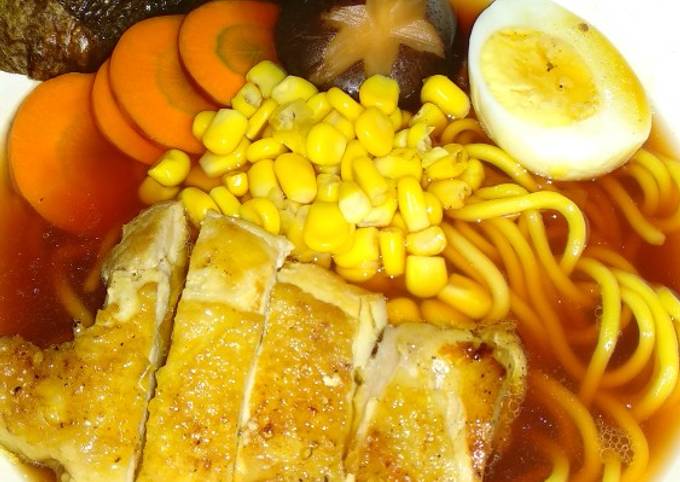Resep: Zero Waste Ramen yang Enak!
Zero Waste Ramen. So I was trying to come up for a recipe that my friend would like, and I decided to combine a few little tricks I've learned over the years. Since I live in an apartment, I don't have a backyard, or anywhere to compost, and all my veggie scraps would always go to waste. So, after a while, I started to make veggie.
 I will start by saying that this ramen has nothing to do with the traditional one prepared here in Japan (which certainly remains the most appreciated by mos. Tokyo Ramen serves classic Japanese food in Cabbagetown, Toronto. A zero waste option for takeout containers. Sobat dapat memasak Zero Waste Ramen hanya dengan menggunakan 16 bahan dan 8 langkah saja. Berikut ini bahan dan cara untuk memasaknya, bikin Zero Waste Ramen yuk!
I will start by saying that this ramen has nothing to do with the traditional one prepared here in Japan (which certainly remains the most appreciated by mos. Tokyo Ramen serves classic Japanese food in Cabbagetown, Toronto. A zero waste option for takeout containers. Sobat dapat memasak Zero Waste Ramen hanya dengan menggunakan 16 bahan dan 8 langkah saja. Berikut ini bahan dan cara untuk memasaknya, bikin Zero Waste Ramen yuk!
Bahan-bahan Zero Waste Ramen
- Dibutuhkan of Veggie scraps perfectly washed and clean.
- Gunakan 2 of boneless chicken thighs.
- Sediakan of Fresh or dry ramen noodles.
- Siapkan 1 of Roasted Nori sheet.
- Diperlukan 2 of eggs.
- Sediakan 1/2 cup of soy sauce.
- Diperlukan 1/2 cup of chicken stock or dashi stock.
- Gunakan 1 clove of garlic.
- Siapkan 1 inch of slice of fresh ginger.
- Siapkan 1 of scallion.
- Dibutuhkan 2 tsp of brown sugar.
- Gunakan 1 tsp of rice vinegar.
- Dibutuhkan 1/4 cup of mirin.
- Gunakan 1/4 cup of sake or dry white wine.
- Gunakan of Toppings of your choice.
- Dibutuhkan to taste of Salt and pepper.
Frozen bundles of ramen noodles locally made by Crafty Ramen in Kitchener, ON. Top your ramen with shichimi togarashi (Japanese seven spice), a popular ramen condiment. Cooking Instructions: Bring a pot of water to a boil. Our original recipe brothless ramen noodles are a healthier take on this classic convenience food.
Cara memasak Zero Waste Ramen
- Put veggie scraps in a large heavy pot and cover with water. Add around 2 tsp of salt, and bring to a boil. Boil them in high heat for about an hour tops..
- Remove the pot from the fire and strain the veggie scraps, reserving the resulting broth. It will be very bland. Don't worry, you can adjust the seasoning later..
- In a sauce pan mix the chicken or dashi stock with the soy sauce, the mirin, sake, sugar, rice vinegar, smashed garlic and ginger, and scallion. Stir and bring to a simmer. Cook on low heat until the mixture has reduced to about 1/2 cup of liquid. Be careful not to let the soy sauce burn. This will be the Tare, and will adjust the seasoning of the ramen..
- Boil two eggs, straight from the fridge, for 6 minutes. Start counting once the water starts boiling. The yolk should come up soft, or at least, perfectly yellow with no grayish rim..
- Add salt and pepper to both chicken thighs. In a skillet, cook the thighs skin side down first, until crispy and golden. Then flip and repeat. Set aside to rest, then cut each thigh into bite size strips..
- Cook the ramen noodles as instructed in the package. If you can't find any, use fresh spaghetti and replace the salt in the water with baking soda (sodium bicarbonate). Around 2 tsp should do..
- Fold the nori sheet four times and cut it into little rectangles..
- Finally, assemble the ramen: place 3 tbsp of tare in the bottom of the bowl, then add the noodles, followed by 4 ladlefuls of veggie broth. Place the toppings on top (the chicken thigh, and the egg sliced in half, and 4 nori sheets). I also added a shitake mushroom, a few slices of carrot, and corn. Be creative, and add any topping you want. Some flavoured oil can also add a great finishing touch (chilli oil, sesame oil, garlic oil, etc)..
Made with a special technique that eliminates the need for deep frying, they're lower in fat than traditional ramen noodles. Additionally, we never add MSG or harsh chemical additives. To Eliminate Plastic, College Grad Designs Ramen Packaging That Dissolves in Hot Water. Inspired by countless nights spent studying in school, an eco-conscious college grad has come up with an. If the dough is sticky or wet, add flour.
0 Response to "Resep: Zero Waste Ramen yang Enak!"
Post a Comment